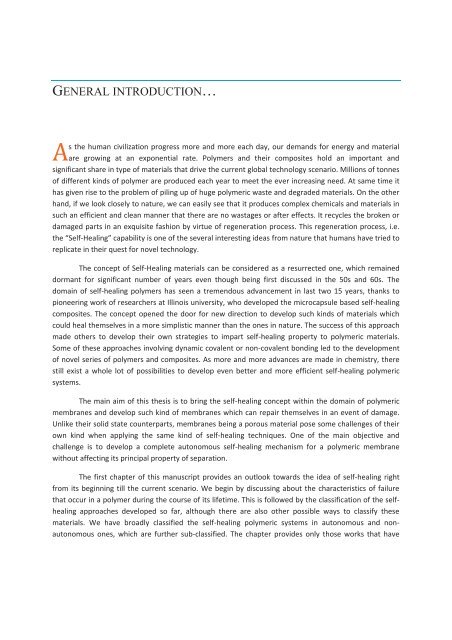4(%3)3 - Ecole nationale supérieure de chimie de Montpellier
4(%3)3 - Ecole nationale supérieure de chimie de Montpellier
4(%3)3 - Ecole nationale supérieure de chimie de Montpellier
Create successful ePaper yourself
Turn your PDF publications into a flip-book with our unique Google optimized e-Paper software.
As the human civilization progress more and more each day, our <strong>de</strong>mands for energy and materialare growing at an exponential rate. Polymers and their composites hold an important andsignificant share in type of materials that drive the current global technology scenario. Millions of tonnesof different kinds of polymer are produced each year to meet the ever increasing need. At same time ithas given rise to the problem of piling up of huge polymeric waste and <strong>de</strong>gra<strong>de</strong>d materials. On the otherhand, if we look closely to nature, we can easily see that it produces complex chemicals and materials insuch an efficient and clean manner that there are no wastages or after effects. It recycles the broken ordamaged parts in an exquisite fashion by virtue of regeneration process. This regeneration process, i.e.the “Self-Healing” capability is one of the several interesting i<strong>de</strong>as from nature that humans have tried toreplicate in their quest for novel technology.The concept of Self-Healing materials can be consi<strong>de</strong>red as a resurrected one, which remaineddormant for significant number of years even though being first discussed in the 50s and 60s. Thedomain of self-healing polymers has seen a tremendous advancement in last two 15 years, thanks topioneering work of researchers at Illinois university, who <strong>de</strong>veloped the microcapsule based self-healingcomposites. The concept opened the door for new direction to <strong>de</strong>velop such kinds of materials whichcould heal themselves in a more simplistic manner than the ones in nature. The success of this approachma<strong>de</strong> others to <strong>de</strong>velop their own strategies to impart self-healing property to polymeric materials.Some of these approaches involving dynamic covalent or non-covalent bonding led to the <strong>de</strong>velopmentof novel series of polymers and composites. As more and more advances are ma<strong>de</strong> in chemistry, therestill exist a whole lot of possibilities to <strong>de</strong>velop even better and more efficient self-healing polymericsystems.The main aim of this thesis is to bring the self-healing concept within the domain of polymericmembranes and <strong>de</strong>velop such kind of membranes which can repair themselves in an event of damage.Unlike their solid state counterparts, membranes being a porous material pose some challenges of theirown kind when applying the same kind of self-healing techniques. One of the main objective andchallenge is to <strong>de</strong>velop a complete autonomous self-healing mechanism for a polymeric membranewithout affecting its principal property of separation.The first chapter of this manuscript provi<strong>de</strong>s an outlook towards the i<strong>de</strong>a of self-healing rightfrom its beginning till the current scenario. We begin by discussing about the characteristics of failurethat occur in a polymer during the course of its lifetime. This is followed by the classification of the selfhealingapproaches <strong>de</strong>veloped so far, although there are also other possible ways to classify thesematerials. We have broadly classified the self-healing polymeric systems in autonomous and nonautonomousones, which are further sub-classified. The chapter provi<strong>de</strong>s only those works that have











